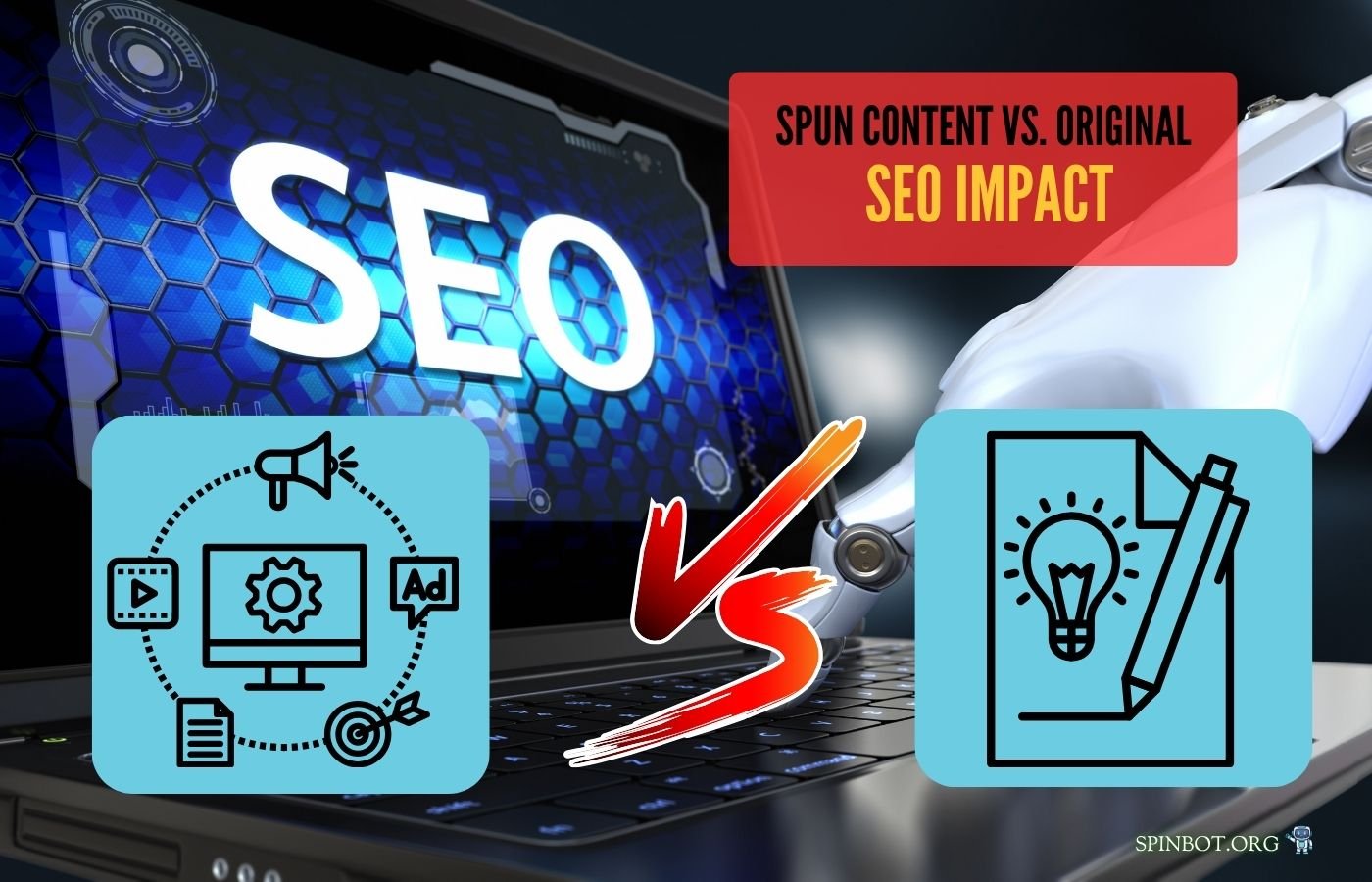1. What is Spun Content?
Spun content refers to text that is generated by replacing words or phrases in an existing article using software or tools. This process creates “new” content by altering the original material, aiming to make it unique in appearance but not necessarily in substance.
How is Spun Content Created?
Spun content is created using various article spinning tools that automatically change words, sentences, or paragraphs. These tools typically replace words with synonyms or rephrase sentences to generate different versions of the original text. The main goal of spinning is to avoid duplicate content penalties while keeping the core message intact.
Examples of Spun Content
Imagine you have an article about SEO tips. If you use a spinning tool, it might change sentences like:
Original: “SEO strategies help websites rank higher on search engines.”
Spun: “SEO tactics assist websites in achieving better rankings on search engines.”
While the words are different, the meaning remains largely the same. This type of content is often used by websites looking to churn out large volumes of content quickly.
Why Do People Use Spun Content?
The primary reason many opt for spun content is speed. It’s a way to produce a high volume of content in a short time. Additionally, spun content may be used to circumvent duplicate content issues, as search engines will treat the spun version as unique. However, this tactic carries several risks, especially from an SEO perspective.
2. What is Original Content?
Original content refers to content that is created from scratch, offering fresh, unique insights, information, or entertainment that has not been copied or repurposed from other sources. It’s crafted with originality and value in mind, often targeting the audience’s needs and interests.
How is Original Content Created?
Original content is the result of thoughtful research, writing, and analysis. It’s typically produced by individuals who understand the topic well and are skilled in crafting engaging and informative pieces. Original content can be blog posts, articles, videos, podcasts, or even social media posts.
Examples of Original Content
An example of original content could be:
“To optimize your website for SEO, consider improving user experience by simplifying navigation and focusing on mobile responsiveness. These strategies are proven to improve rankings in Google.”
This content is fresh, valuable, and directly related to the topic, making it highly relevant for readers.
Why is Original Content Important for SEO?
Search engines like Google highly prioritize original content because it provides value to users. Original content is often deemed trustworthy and authoritative, which can significantly improve your website’s ranking over time.
3. The SEO Impact of Spun Content
Spun content may offer a quick solution for creating content, but it doesn’t come without drawbacks. While it might seem like a good idea to generate unique articles, spun content can negatively affect SEO in several ways.
How Search Engines Handle Spun Content
Search engines, particularly Google, have become adept at detecting spun content. Google’s algorithms, such as Panda, penalize low-quality content that doesn’t provide real value. This includes content that is simply reworded without offering new or useful information. While spun content may initially pass as unique, it often lacks depth and relevance, which can lower its SEO performance.
Potential SEO Penalties for Spun Content
Google Panda Algorithm: This algorithm targets websites with low-quality, thin, or duplicated content. Spun content, often perceived as spammy, can be penalized under this update.
Lower Search Rankings: Spun content rarely engages users, and as a result, it leads to higher bounce rates and lower rankings.
Lack of User Engagement: If the content feels robotic or doesn’t provide valuable insights, users will likely spend less time on your page, impacting your site’s overall SEO health.
Risks Associated with Spun Content
Poor User Experience: Spun content often lacks coherence, making it hard to read and less engaging.
Reputation Damage: Websites relying on spun content may gain a reputation for providing low-quality content, affecting brand credibility.
4. The SEO Impact of Original Content
Original content, on the other hand, is favored by search engines and offers a range of benefits that directly contribute to SEO success.
How Search Engines Treat Original Content
Google’s algorithms reward original content because it provides value to users. Unlike spun content, original content is unique, informative, and relevant to the search query. Search engines prioritize content that answers users’ questions in a detailed and thoughtful manner.
Long-Term Benefits of Original Content for SEO
Better Rankings: Google rewards original, high-quality content with better rankings. Over time, this leads to higher organic traffic and visibility.
Increased User Engagement: Original content is more likely to keep users on your page, reducing bounce rates and increasing time spent on-site—both important ranking factors for SEO.
Authority Building: Websites that consistently produce original content become trusted sources in their niche. This can lead to more backlinks, which are a significant ranking factor.
The Role of Original Content in Building Backlinks
Backlinks are essential for SEO success. Original, well-researched, and valuable content is more likely to attract natural backlinks from other websites, which can significantly boost your SEO rankings.
5. Comparing Spun Content and Original Content in SEO
When comparing spun content with original content, it becomes evident that originality is critical for SEO success.
Key Differences Between Spun and Original Content
| Aspect | Spun Content | Original Content |
|---|---|---|
| Quality | Often low-quality, lacks depth | High-quality, informative, valuable |
| Uniqueness | Reworded, not truly unique | Completely unique, fresh insights |
| SEO Impact | Can result in penalties | Improves rankings, boosts engagement |
| User Experience | Hard to read, robotic | Engaging, easy to understand |
SEO Performance Comparison
Spun Content: May provide short-term results but often backfires in the long run due to penalties and poor user engagement.
Original Content: Consistently ranks higher and provides long-term SEO benefits, including more organic traffic, better rankings, and increased authority.
6. Case Studies and Real-World Examples
Let’s take a look at a couple of case studies to understand how spun and original content perform in real-world scenarios.
Example 1: Website Using Spun Content
A website that uses spun content might rank for a short period but eventually sees a decline in traffic. This is due to the content being flagged by Google’s algorithm, which recognizes it as low-quality. The website may eventually face penalties that result in a drop in rankings.
Example 2: Website Using Original Content
A competitor website that consistently creates original, high-quality content, on the other hand, will experience steady growth in organic traffic. Over time, Google recognizes the value of the content, and the website climbs in rankings, receiving a substantial amount of backlinks and social shares.
7. Ethical Considerations and Content Strategy
When considering spun content, there are significant ethical concerns. Spun content is often seen as an attempt to deceive search engines and readers. Using such practices can harm your reputation and credibility.
Importance of Transparency and Authenticity
As a content creator, it’s important to maintain transparency and authenticity in your work. Original content helps build trust with your audience and search engines, while spun content undermines that trust.
8. Best Practices for SEO Content Creation
To ensure your content performs well in search engines, follow these best practices for creating high-quality original content:
Focus on Quality: Always aim to create content that offers value and is informative.
Use LSI Keywords: Include semantically related keywords to ensure your content is comprehensive.
Make Content Engaging: Write in a conversational style and include actionable tips that users can implement.
Avoid Spun Content: Never rely on spinning tools to create content. Always prioritize originality.
9. The Future of SEO and Content Creation
As SEO continues to evolve, content quality will remain a top priority. With advancements in AI and machine learning, search engines are becoming better at distinguishing high-quality, original content from spun or low-value content.
Google’s Stance on Spun Content
Google’s algorithms are becoming more sophisticated and can now detect spun content with a high degree of accuracy. In the future, websites that use spun content may face even harsher penalties.
Emerging Trends in Content Creation
AI-generated Content: The future of content creation may involve more AI tools, but they must be used to assist rather than replace the human touch.
Focus on User Intent: Search engines will continue to prioritize content that satisfies user intent, so focusing on creating high-value, informative articles will always be a winning strategy.
Conclusion
In conclusion, while spun content may offer a shortcut for creating unique text, it often results in penalties and poor SEO performance in the long run. On the other hand, original content provides significant long-term SEO benefits, from better rankings to higher user engagement. The SEO landscape continues to evolve, but one thing remains clear: high-quality, original content is the key to SEO success.
For any website aiming to thrive in the competitive digital world, investing in original content creation is the best approach.

Academic editor turned AI copy pro, Sarah-Jane fuses research precision with smart storytelling. Her insights build trust, spark ideas, and elevate every word with real-world writing experience.

